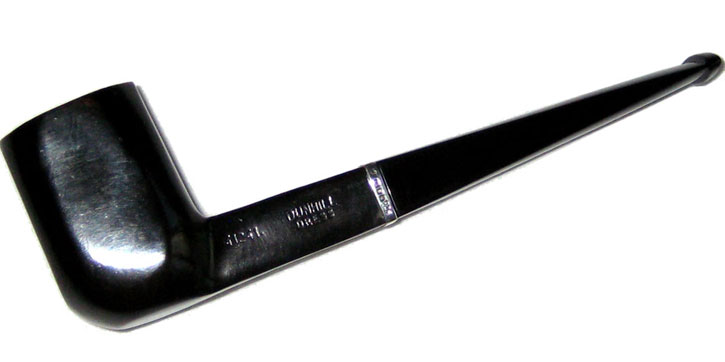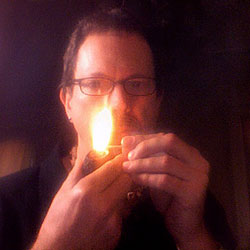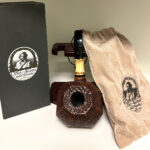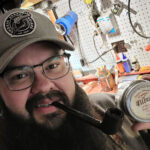G. L. Pease
 The problem with writing a Q&A column is that there’s always someone with a question that’s just plain hard. This is compounded, unfortunately, by the fact that I’ve always been the curious sort, and if I don’t have a ready answer to an interesting question, I can get bogged down in the research for hours, days, weeks. The Internet, fortunately, is a wonderful tool, and makes that research easier, putting all sorts of fascinating information at my fingertips. And, yes, I’m making an excuse, here, hoping to, somehow, justify the seemingly endless stream of old Avengers videos I watched in the interest of research. At long last, the answer is no, I don’t think John Steed ever smoked a pipe. Glad to put that one to rest, so I can get on to the other questions this month.
The problem with writing a Q&A column is that there’s always someone with a question that’s just plain hard. This is compounded, unfortunately, by the fact that I’ve always been the curious sort, and if I don’t have a ready answer to an interesting question, I can get bogged down in the research for hours, days, weeks. The Internet, fortunately, is a wonderful tool, and makes that research easier, putting all sorts of fascinating information at my fingertips. And, yes, I’m making an excuse, here, hoping to, somehow, justify the seemingly endless stream of old Avengers videos I watched in the interest of research. At long last, the answer is no, I don’t think John Steed ever smoked a pipe. Glad to put that one to rest, so I can get on to the other questions this month.
H.R. writes: Many have commented on the "ketchup" odor of certain Virginia blends, the result of vinegar produced during fermentation. (I always noticed a pronounced "dill pickle" aroma in the old Sullivan Powell’s Gentleman’s Mixture.) Do tobacco processors and blenders use specifically chosen yeast, acetobacter or lactobacillus cultures to engender the results they want, or are they just letting nature take its course, as did the winemakers, brewers and bakers of old? Has anyone ever tried using Dekkera/Brettanomyces to produce a "Belgian" style pressed Virginia flake?
 A: Personally, I’ve never quite been able to grok the "ketchup" thing. Certainly, there are some tobaccos that exhibit an acetic aroma, and with some expansion of the imagination, I might be able to find something akin to BBQ sauce on occasion, or perhaps Branston Pickle, but not ketchup. I’ve even gone so far as to open a bottle of ketchup and compare its aroma side-by-side with that of the most infamous of "ketchup" tobaccos, and I still don’t get it. I think people confuse their condiments, sometimes. Next thing you know, it’ll be mustard, and arguments will ensue over whether it’s Dijon or yellow.
A: Personally, I’ve never quite been able to grok the "ketchup" thing. Certainly, there are some tobaccos that exhibit an acetic aroma, and with some expansion of the imagination, I might be able to find something akin to BBQ sauce on occasion, or perhaps Branston Pickle, but not ketchup. I’ve even gone so far as to open a bottle of ketchup and compare its aroma side-by-side with that of the most infamous of "ketchup" tobaccos, and I still don’t get it. I think people confuse their condiments, sometimes. Next thing you know, it’ll be mustard, and arguments will ensue over whether it’s Dijon or yellow.
More seriously, you’re right in that fermentation is the cause of this notable aroma, whatever someone may choose to call it. To the best of my knowledge, blending houses don’t inoculate their tobaccos with specific microflora in order to get these effects, but rely on the wild yeasts and bacteria that are present in their environment. One one occasion, I managed to recreate a similar effect, albeit accidentally, so I’m quite sure it’s not the result of any sort of additives; just the natural process that tobacco goes through under certain controlled conditions.
I like the idea, though, of using specific saccharomyces to excite fermentation in a tobacco. It might make for an interesting red ale. And, from the trivia department, the aging of tobacco was once referred to as lagering. Maybe beer and tobacco are linked more closely than we know.
Tim asks: I have been reading a lot lately on forums/NASPC etc about the decline of the factory pipe. Now, we all know about Comoy, Sasieni, GBD etc where there was a real material change in the quality of their pipes. For example, I love my old Comoys but you could not pay me to smoke a Cadogan era Comoy (well, for a few free pounds of Robusto I might…). More recently people are talking about Castello and Dunhill diminishing as brands.
I am wondering how much you think brand reputation is subject to change because of purchases being made over the internet where the purchaser does not have a chance to inspect a pipe before they buy. For example, I used to live in a city with a great tobacconist. Before I bought a pipe I inspected the draft hole, fit etc and if it wasn’t up to my standard, or the standard set by the brand, then I simply purchased a different pipe with a net loss to my life of about 30 seconds. If however, as happened to me since I moved to a small town and don’t have a local B&M, I purchase a high end factory pipe from an e-tailer (who lets say probably sells thousands of pipes a year). I don’t know until the pipe is delivered to me that draft hole is off centre or doesn’t align with the stem. In which case I need to mail back the pipe to the retailer, and order another one or wait for another one similar to become available. Chances are a high volume e-tailer cannot inspect every pipe that they sell. My level of faith in the brand (whatever it is) suffers a lot more than it would if I simply picked it up in a tobacconist’s shop and decided I didn’t like the quality of work.

Now most British factory brands of pipes diminished long before the internet became a standard source of commerce (i.e. Comoy), and there was a rise in the artisanal pipe maker filling the void (who I trust do not send out bad pipes). So, is there really a diminishing in the quality of high end factory pipes or is it more perceptual than real? For instance, I am sure next to all the great pipes Comoy turned out in its prime they probably sent out a few duds too….
Does the frustration of having to buy on faith when buying online contribute to the perception (real or not) that the quality of the high-end factory pipe is falling?
A: "You sure do ask a lot of questions for a guy from New Jersey." –Roseanne Roseannadanna
When tobacconists’ shops were as ubiquitous as Starbucks, and the factory pipe was king—and everyone seems to have their own idea of when that was, but it was certainly at a time when a higher percentage of the population smoked pipes—it was essential that quality be maintained to at least some standard of consistency. If the retailer didn’t find the products from a particular maker satisfactory, he wouldn’t stock them. Further, if a pipe smoker had certain expectations from a particular marque, and a pipe didn’t deliver, the company risked losing a fan.
But, it’s also important, probably even more so, to remember that from where we sit, we’re looking back at the past through the distorted glass of time. Certainly, decades ago, factories produced duds as well as great pipes, but from here, how would we know? The good pipes have survived, the bad ones have long since been tossed in the bin, so we might incorrectly be led to the notion that pipes were "better back then." I’m not sure it’s true.
 It does seem, though, that factory pipes, at least from some marques, did suffer in quality during the decline of pipe smoking in the 1970s and beyond. (It’s heartening that there seems to be an upswing over the past few years, and our numbers have grown by about 30%!) The reasons behind this are likely economic, of course. Aren’t they always? It seems that more attention was given to fancy finishes, or shank applications, or clever stem work than to the all important briar, itself. If a couple of brass bands or other "bling" could be used to make a pipe look better than it was, it might have made an easier sale. But, that’s just a guess.
It does seem, though, that factory pipes, at least from some marques, did suffer in quality during the decline of pipe smoking in the 1970s and beyond. (It’s heartening that there seems to be an upswing over the past few years, and our numbers have grown by about 30%!) The reasons behind this are likely economic, of course. Aren’t they always? It seems that more attention was given to fancy finishes, or shank applications, or clever stem work than to the all important briar, itself. If a couple of brass bands or other "bling" could be used to make a pipe look better than it was, it might have made an easier sale. But, that’s just a guess.
Today, as you point out, there are fewer and fewer brick and mortar tobacconists, and people are increasingly driven to purchase via the net. But, I don’t think this can be seen as a cause of a decline in quality. In fact, overall, it’s possibly the driving force behind an overall increase in quality pipes being more readily available, though mostly from small, independent makers rather than the larger factories. It’s never been easier to find a greater assortment of pipes to peruse, and it’s never been easier to gather information about the work of particular makers. This, in a sense, serves to keep the makers honest. If they produce second-rate work, the world will know within minutes.
Getting back to factory pipes, though, the story is a little different. In the middle of the 20th Century, when factories were turning out millions of pipes yearly, it’s actually likely that the overall quality of the briar itself was more variable than it is today. The inventory costs associated with aging the wood, alone, would be immense. If you consider a factory like Castello, who today turns out about 3000 pipes per year, each made from briar that’s been aged for 10 years or more, the inventory load is huge. If you multiply that production figure by 100, it becomes impossible, meaning it is highly unlikely that the really big factories aged their wood for very long "back in the day." With fewer pipes being made, more attention can be paid to the individual pieces. Maybe today’s factory pipes are actually better, overall, than they were "back in the day." (I can only support this postulate with scant anecdotal evidence. I’ve smoked some modern factory pipes that were excellent from the first bowl, and have had a few old, unsmoked, "new old stock" pipes that were dreadful. I suspect that much of the mythos of the horrors of breaking in a pipe stem from a time when briar was NOT typically as well seasoned as it is today.)
But, volume offers some advantages, too, and it’s possible that economies of scale afforded the larger factories to leverage their buying power to get the better wood. Did the better factories receive better briar from the mills, or did they simply discard more of what they got, or turn them into "lesser" grades and seconds? Again, more questions than answers.
The picture of the past is blurry, too often presented in a romantic pastel rendering, rather than in stark photographic reality. As Roseanne would have said, "It just goes to show you, it’s always something. If it ain’t one thing, it’s another." It does give us something interesting to ponder over a bowl or two of our favorite tobaccos in a good pipe, old or new.
If you’re still here after that bit of windy discourse, here’s a few questions from Chris:
 Thanks for sharing your extensive knowledge on tobacco and pipes. I’ve devoured your blog(s) and articles and always look forward to more. Your nose for the leaf is also without par; a good 90% of my smoking is your blends.
Thanks for sharing your extensive knowledge on tobacco and pipes. I’ve devoured your blog(s) and articles and always look forward to more. Your nose for the leaf is also without par; a good 90% of my smoking is your blends.
-Have you had any recent tests on the age progression of the Old London Series? Can we expect to see this updated on your website anytime soon? Do you need a hand? *wink* I especially can’t get enough of Chelsea Morning and look forward to seeing what happens after 20 months, which I’m currently finishing a tin of.
-It would be interesting to read how an expert on getting the most out of flavors such as yourself keeps their pipes clean. A rundown on what you do with your pipe before you put it away, to any periodic cleaning would be interesting. Part of this comes about from the varied opinions I’ve read, such us those that suggest shaking ashes around to help develop cake, vs. those that suggest wiping the bowl out after every use.
A: Thank you for the kind words, Chris. To address your first question, yes! I’ve been sampling the Old London Series continually since I released them, and they’re doing fabulously. I think Chelsea Morning has a very long life expectancy, as the virginias and orientals continue to develop increased complexity from long aging. As the Latakia softens, it will take on a less important role, of course, but the added depth from the other components will more than make up for it. Meridian, too, I suspect will be fantastic well into its teens, and beyond, for similar reasons. (Then again, I happen to like the softer side of aged Latakia. Someone who prefers the brashness of its youth might disagree.) Lagonda and Quiet Nights will probably peak before they hit their tenth birthday, but I’ve been wrong before, and they might have longer legs than I anticipate. Check with me in another decade on those. In any case, they’ll all shine brightly at the five-six year mark, and I’m looking forward to opening tins then.
On cleaning pipes, there seems to be a lot of variance amongst different smokers. I do recall one fellow who insisted that a pipe is only good when it’s shank had been allowed to accumulate tars, and those tars allowed to "mellow" over time. I’m sure it worked for him, but it doesn’t for me. I’m pretty much in the opposite camp, here. I clean my pipe quite thoroughly after every smoke, using enough cleaners to scrub the shank until the cleaners come out, um, clean. I’m also a believer in resting pipes between smoking session, and find that a couple weeks or even a month’s holiday can revitalize a pipe that’s getting a little tired from being pressed into service too much. Whenever I come back to a pipe that is well rested, it seems to offer a more flavorful, purer smoke that I enjoy.
Not everyone will be in a position to do this, either because they smoke their pipes more frequently, or because they don’t want to amass a month’s rotation. And, it’s true that a lot of pipesters smoke their pipes repeatedly and relentlessly, and derive a great deal of pleasure from them. My smoking requirements are arguably a little different from the average pipe smoker’s, because I’m often critically evaluating a new blend, or an old one, and need to have the purest expression of the tobacco possible. (I’ve also been accused of being a little compulsive, but that’s another story.)
Despite my routine ministrations, a pipe will still need an occasional deeper cleaning, and alcohol (vodka works fine) and a few pipe cleaners can often cure the ills of a pipe that’s gone a little sour. I usually do this in concert with a trimming of the cake, and it usually restores an "off" tasting pipe. In my experience, an overworked, undercleaned pipe can cause a wonderful tobacco to appear like a fire breathing monster. To me, a clean pipe is a happy pipe, and a happy pipe makes a happier pipe smoker.
As for cake building, it seems to pretty much take care of itself. Sometimes, I shake my ash (often to the chagrin of those who have accompanied me to the dance floor), and sometimes, I don’t. It doesn’t really seem to make much difference. More proof of my belief that if you ask 100 pipe smokers a question about pipe smoking, you’ll get at least 101 answers, and they’ll all be right.
 Ben wants to know: Would it be feasible to produce Latakia in the US? Have any American blenders attempted to fire cure oriental leaf, and if not why not? It seems to me those rare aromatic woods (cedar, juniper, etc) so scarce in present day Syria could be obtained more easily in the US, and the requisite curing could be done in barns just as it is for American Dark Kentucky. Thoughts?
Ben wants to know: Would it be feasible to produce Latakia in the US? Have any American blenders attempted to fire cure oriental leaf, and if not why not? It seems to me those rare aromatic woods (cedar, juniper, etc) so scarce in present day Syria could be obtained more easily in the US, and the requisite curing could be done in barns just as it is for American Dark Kentucky. Thoughts?
A: Possible, yes. Feasible? Not so much. The production of a fire-cured tobacco, whether it’s Kentucky dark or Latakia, requires careful timing and critical control. In order to produce something Latakia-like, it would be necessary, first, to either get the oriental leaf here in just the right condition, at just the right time, or to grow it here, neither of which is possible, in any real sense.
The leaf has to be yellowed to a specific point before the fires are started. With the oriental varieties, the leaf is initially sun-cured, while Kentucky is air-cured to a specific stage of yellowing. Once it’s reached the right point, there’s no time to lose shipping it half-way round the world for final fumigation.
So, why not just grow it here? Oriental seed grown in US soil produces a very different tobacco. We haven’t the soil conditions, nor the right climate to produce the right leaf to start with, one of the reasons we continue to import oriental tobaccos from the parts of the world in which it grows true to type, rather than grow it domestically.
So, yes, something similar to Latakia could be produced in the US, but it wouldn’t be the same, and would likely cost more, so it’s not likely to happen.
Tony writes: Greg, I am amazed. Simply amazed when you and others describe the flavors of pipe tobacco blends and cigars. I occasionally wonder how in the heck you guys know what all these things tastes like. I almost envision you and other folks in the business purposely maybe get together and actually taste all the spices, sweeteners, woods, charcoal, (bbq), flowers, etc. just to be able to present a description of a blend/cigar. I don’t know how you can word this if you choose to use this question but I’m sure you get my drift. My question? How in the world do you folks come up with such an incredible array of what things tastes like? It’s hard for me to believe that ya put all these thing in your mouths just for the taste experience. Please let us know how ya do it?
 A: Tony, anyone can increase their flavor "vocabulary" with some practice and attention. Each time you taste something, try to make a note of what it might remind you of. Sometimes it’s helpful to sniff spices, fruits, or that steak that’s been in the fridge for a week too long, just to reinforce the neural pathways connected with common aromas. Everyone knows what a lemon smells like, or an orange, or a grapefruit. Though these are similar citrus fruits, they each have a unique taste/aroma. Taken to the next level, the flesh of the fruit is very different from the pith, which is different from the zest, and the oils that can be coxed from it with a little twist. You can probably easily conjure a pretty fair idea of these things in your mind’s nose, so to speak.
A: Tony, anyone can increase their flavor "vocabulary" with some practice and attention. Each time you taste something, try to make a note of what it might remind you of. Sometimes it’s helpful to sniff spices, fruits, or that steak that’s been in the fridge for a week too long, just to reinforce the neural pathways connected with common aromas. Everyone knows what a lemon smells like, or an orange, or a grapefruit. Though these are similar citrus fruits, they each have a unique taste/aroma. Taken to the next level, the flesh of the fruit is very different from the pith, which is different from the zest, and the oils that can be coxed from it with a little twist. You can probably easily conjure a pretty fair idea of these things in your mind’s nose, so to speak.
Where the challenge comes, for most of us, is in making the connections between things that are dissimilar. If we smoke a tobacco that has a hint of grapefruit rind in its taste or aroma, we might not identify it quickly, because other cues aren’t present. Who ever heard of grapefruit aromas in tobacco? Yet, once that connection is made, it’s locked in, and the next time, the identification will be more spontaneous. Repeat this for years, and you’ve got a lot of well reinforced experiences to draw from.
Since I’ve been involved with food, wine, and spirits for most of my life, I can often draw on these experiences when qualitatively examining a blend, or trying to describe its taste and aromas to others. It’s just an inadvertent practice that’s taken place over a long time. And, remember, we do this for a living, so we’re in a sort of forced predicament of tasting, smelling critically. Like anything else, practice yields its rewards over time. Take notes, keep a journal of what you’re smoking and what you get from it. When you read a review, see if you can pick out the same tastes and aromas. You’ll be describing tobaccos like a pro in no time.
What’s funny along these lines, at least to me, is when people insist that smoking dulls the senses. I can taste and smell things more acutely today than ever before. It’s just another way the anti-tobacco folks are full of codswallop.
Until next month, keep ’em coming, folks, but try to ask some easier ones. My brain, like my pipes, needs a little rest once in a while. And, don’t forget to drop in on my Out of the Ashes columns.
-glp

Since 1999, Gregory L. Pease has been the principal alchemist behind the blends of G.L. Pease Artisanal Tobaccos. He’s been a passionate pipeman since his university days, having cut his pipe teeth at the now extinct Drucquer & Sons Tobacconist in Berkeley, California. Greg is also author of The Briar & Leaf Chronicles, a photographer, recovering computer scientist, sometimes chef, and creator of The Epicure’s Asylum. |


















Another winner Mr. Pease! You are keeping me busy at this desk job reading your articles! But now you have me wondering what American Latakia would taste like…
Great info and very interesting questions this round (well, each round). I can’t wait to try my first 5 year and 10 year old tins of Chelsea Morning. What a great hobby we have that gives us experiences to look forward to years from now.
Makes me think, the first tins of Westminster are now 5 years old, I wonder how that has fared. I would love to hunt a tin or two of that down.
Hmmm… the universe keeps telling me to try Chelsea Morning and here it is again! Thanks for the fun article, Mr. Pease. 😀 I love the vocabulary too – grok and codswallop need to be used more often.
Thank you Mr. Pease. At 56 yrs old I’m still learning. I lovin’ it!
I have a tobacco journal and make an entry whenever i get a new tobacco. Sometimes I have to catch up a month or so even just entering that I sampled another blend. It’s a 6″x9″ journal book. Maybe I need a smaller one so it’s easier to grab and jot things down?
Regarding “American Latakia”, in case it wasn’t clear, it’s really impossible to produce Latakia here that would even come close to resembling the Middle Eastern Latakia that we know.
–
Something Greg didn’t say, that I have read elsewhere – is that past attempts to grow Oriental varietals here in the USA resulted in tobacco that resembled Burley.
–
Look at the photo above where you see very small leaves in someone’s hands. Those are Oriental tobacco leaves. They are so small that he has about 20 – 30 of them in his hand. One Burley leaf is bigger than your head.
Thanks for reading! It’s always nice to know that people are enjoying the column.
Chris, Westminster ages very well. It’s got a lot of oriental leaf in it, and only a little virginia, so it develops differently than a more virginia dominated mixture would. There are more complex, spicy notes, less of the typical fruitiness that virginias develop. It’s been a while since I’ve opened an aged tin, myself. I’ll have to see what I’ve got gathering dust in the cellar and correct that!
A thought on the “declining” quality of factory pipes is the fact that I’m a lot more critical now of things like engineering faults than when I knew nothing 50 years ago; unless it tasted vile it was OK then. Perhaps I was happier then?
Tasting is one thing – taste memory another; for me to build up a “memory palace” requires side by side tasting; even more true of wine than baccy for me.
Thank You Mr Pease for publishing your work for all to enjoy! I’ve been reading your stuff on this site and the Chronicles for better than a year now and decided I should join up so I could voice my appreciation too. Well done sir.
You may remember me from when I became a customer of yours. We talked about Morse Code Keys. Regards, and keep up the fine work.
Wow, Greg. Excellent questions and answers! A completely enjoyable time spent reading. Probably one of, if not my most looked forward to web publications covering the pipe and pipe tobacco hobby. I will have to send a question or two, and hope you answer it. As a person who wants to learn about pipe collecting, fair market values, Tobacco cellaring, and other aspects to increase my enjoyment while lowering my risk, I think this is an invaluable resource.
Great column as always, Greg! I especially appreciate the way you answered the last question regarding how to build one’s tasting vocabulary; being on the business side of food develops this almost by default, but it’s something that anyone can do with a little application of time and thought. I’ve been asked this question many times, and was never able to answer it as succinctly as you just did–I’ll refer folks here the next time it comes up!
Awesome info as always
How strange that I just watched the 1977 episode of SNL where Gilda Rander makes the New Jersey comment quoted above the day before I read this…
Nice article, as always!
Hoi! Gregg,
Hier kan ik nog echt veel van leren, zeer nuttige informatie.
Waar anderen met de info over pijptabak stoppen,ga jij verder.
Dit is voor mij de eerste keer dat ik via de E-Mail kan reageren.
Gregg ga zo voort, je bent nu op de goede weg bezig.
Over mijzelf, ik ben een pijproker sinds 1981.
Regarding building a olfactory vocabulary. The next time you’re at one of those heath shops spend sometime sniffing all of those little essential oil bottles; pure ones not the blends. Also visit your local East Indian spice shop and do the same; olfactory snapshots.
Of course all of this stuff is very subjective and some of the wine cork-dorks spiel off a bunch of poetic metaphors trying to sound clever and witty; pomposity and not sincere. Often, “yup it tastes like good tobacco” is good enough for me. Over analysis can lead to decreased enjoyment of many things; time and place, and not all the time.
Good read Greg. I have a couple tins here, Stratford and Kensington that I’m trying for the first time. I like them both. These are the first of your blends I’ve tried and hope to sample some others. What blends should I stay away from that have a heavy Nicotine hit? My blood pressure is high enough already.